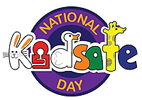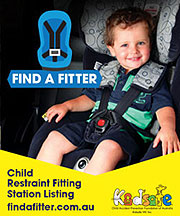Is Your Child Restraint Fitted Correctly?
Tuesday, 27 October 2015 08:42
|
|
|---|
In 1970, 77 Australian children died in motor vehicle accidents with 3000 receiving serious injuries. By 2013, despite the population having doubled, this figure had more than halved, with 35 child fatalities and 1100 receiving serious injuries.
Erica Edmands,
President of Kidsafe Victoria, said over the past 45 years the introduction of
child restraints has had a significant impact in reducing child injuries, a remarkable
outcome given that the population has doubled over this time.
Despite
the significant decrease, transport injuries are still the most common cause of
child injury death and the second most common cause of injury related hospital
admission for Australian children aged 0-14 years. (* Australian Institute
of Health and Welfare)
Ms Edmands said, "With evidence consistently
suggesting that over 70% of child restraints are not fitted correctly, it
is vital that parents and carers are provided with information, advice and assistance
to ensure that their child restraints are fitted correctly and their children
are travelling as safely as possible."
**The incorrect or inappropriate
use of child car restraints increases the risk of injury to a child in a crash
by up to 7 times. (** Neuroscience Research Australia)
"These figures
demonstrate the importance of ensuring that child restraints are fitted correctly
on every trip," said Ms Edmands.
Kidsafe
Victoria is using National Kidsafe Day to celebrate the 45th birthday since the
introduction of child restraints with children and parents at Gowrie Victoria
Carlton North.
The
event will include the launch of 'Find a Fitter', Kidsafe Victoria's new online
child restraint fitting station listing.
The listing will provide parents and carers with easy access to details of credible, experienced child restraint fitters across Victoria who can assist them to ensure their child restraints are correctly installed.
The celebration will include a demonstration to create awareness of the most important issues to check when having a child restraint fitted to a vehicle, to ensure children are travelling as safely as possible.
Andrew Hume, Chief Executive Officer of Gowrie Victoria, who are supporting the
program, said "Child restraints play a vital role in keeping children safe when
travelling in cars and it is important to ensure these restraints are both correctly
fitted and suitable for the child's age."
Parents
and carers will be able to access the new 'Find a Fitter' online child restraint
fitting station listing by visiting www.kidsafevic.com.au or www.findafitter.com.au
Kidsafe Victoria would like to acknowledge the TAC Community Road Safety Grants Program for supporting the development of 'Find a Fitter', as well as valued sponsors, InfaSecure and Safety 1st.
Media
Enquiries:
Ron Smith, Media Communications, Kidsafe Victoria - Mobile: 0417
329 201

MEDIA ALERT
11.00am Tuesday 27 October 2015
45th Birthday of Child Restraints
Incorrect or inappropriate use of child car restraints increases the risk of injury to a child in a crash by up to 7 times.**
Gowrie Victoria
36 Newry Street, Carlton North
Background
information
National child restraint laws
Children 6 months to 4 years of age must:
Children 4 to 7 years of age must:

